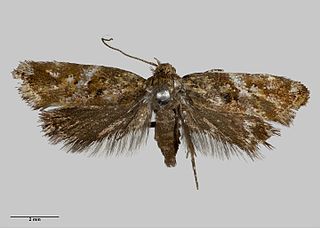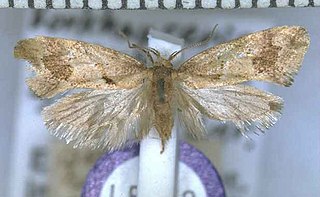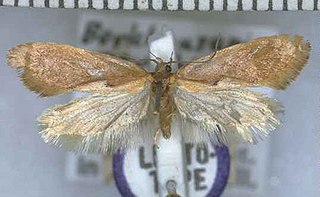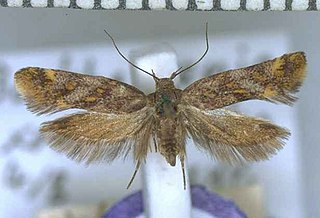
Tingena anaema is a species of moth in the family Oecophoridae. It is endemic to New Zealand and has been collected at Lake Wakatipu, Invercargill and Stewart Island / Rakiura. The adults of the species are on the wing in December.

Tingena berenice is a species of moth in the family Oecophoridae. It is endemic to New Zealand and has been found in the North and South Islands. It is a brightly coloured species which is on the wing in November. Its preferred habitat is mixed beech forest.

Tingena compsogramma is a species of moth in the family Oecophoridae. It is endemic to New Zealand and has been observed in the North and South Islands. This species inhabits native forest and adults are on the win from December until March.

Tingena eumenopa is a species of moth in the family Oecophoridae. It is endemic to New Zealand and found in the North and South Islands. The adults have been found amongst tree ferns and are on the wing in December.

Tingena hemimochla is a species of moth in the family Oecophoridae. It is endemic to New Zealand and has been observed in the North Island. Adults of this species are on the wing from December until March.

Tingena horaea is a species of moth in the family Oecophoridae. It is endemic to New Zealand and have been observed in both the North and South Islands. The adults are on the wing in January.

Tingena idiogama is a species of moth in the family Oecophoridae. It is endemic to New Zealand and has been observed on the slopes of Mount Taranaki. Its preferred habitat is native subalpine scrub and adults are on the wing in January.

Tingena letharga is a species of moth in the family Oecophoridae. It is endemic to New Zealand and has been observed in Otago. Adults are on the wing in December and January.

Tingena maranta is a species of moth in the family Oecophoridae. It is endemic to New Zealand and is found in the lower South Island. Adults of this species are on the wing from October until January. This species prefers grass or low herb habitat. Unlike its close relatives it does not inhabit native forest.

Tingena melanamma is a species of moth in the family Oecophoridae. It is endemic to New Zealand and has been observed in Marlborough, Otago and Southland.

Tingena oxyina is a species of moth in the family Oecophoridae. It is endemic to New Zealand and has been observed in the Otago region. This species inhabits native beech forest at altitudes of between 1000 - 3000 ft. Adults of this species are on the wing in January.

Tingena penthalea is a species of moth in the family Oecophoridae. It is endemic to New Zealand and has been observed in Wellington and the Tararua Range. The adults of this species are on the wing from December until February.

Tingena perichlora is a species of moth in the family Oecophoridae. It is endemic to New Zealand and has been observed in the southern parts of the South Island. This species appears to inhabit manuka scrub. Adults of this species are on the wing from October to January.

Tingena pharmactis is a species of moth in the family Oecophoridae. It is endemic to New Zealand and has been observed in the Nelson, Tasman and Wellington regions. The adults of this species are on the wing in December.

Tingena pronephela is a species of moth in the family Oecophoridae. It is endemic to New Zealand and is found in the southern parts of the South Island. The species inhabits the outskirts of scrub and native forest. The adults of this species are on the wing from October to February.

Tingena robiginosa is a species of moth in the family Oecophoridae. It is endemic to New Zealand and has been observed in the southern parts of the South Island. It has been observed in subalpine habitats at altitudes of between 2700 and 3500 ft amongst Hebe and Cassinia species. The adults of this species are on the wing in December and January.

Tingena siderodeta is a species of moth in the family Oecophoridae. It is endemic to New Zealand and is found throughout the country. This species prefers to inhabit native forest and scrubland but has also been found to be common in cultivated landscapes. The larvae are litter feeders and have been observed in Kanuka and Manuka forest. The adult moths are on the wing from October to February and are day flying but have also been trapped at night.

Tingena siderota is a species of moth in the family Oecophoridae. It is endemic to New Zealand and has been observed at Mount Arthur, Arthur's Pass and in the Hawkes Bay. The adults of this species are on the wing in January and are said to be abundant on the flowers of species in the genus Aciphylla.

Tingena xanthomicta is a species of moth in the family Oecophoridae. It is endemic to New Zealand and has been found in both the North and South Islands. This species inhabits native scrub on hillsides and appears to be attracted to Coprosma areolata. Adults are on the wing from November until February.

Asaphodes prymnaea is a moth in the family Geometridae. It is endemic to New Zealand and can be found on the Mount Arthur tableland. It is common in limestone valleys. The female of the species is paler and has less distinctive markings than the male. Adults are on the wing in January and February.





















